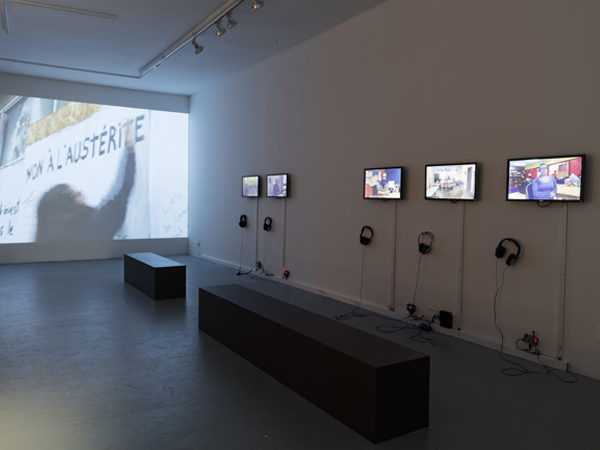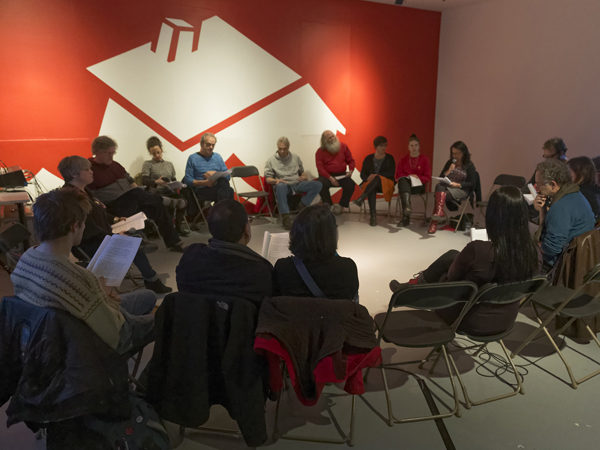The residency of the Canadian-Mexican artist Michelle Tera at LA CHAMBRE BLANCHE in the fall of 2015, took place under the sign of “Diversity”, an issue that closely affects the central areas of Quebec City. Michelle Teran’s brings on a reflection about the meaning of the word that is too easily diverted by our politicians when it comes to intervene in the development of these areas. A video camera in hand, Teran has interviewed five social organizations concerned with the issue of housing in Quebec City and followed some of their activities to produce many short documentaries, presented in the gallery in December. She interviewed the FRAPRU (Front of popular action in urban redevelopment), Le Bail (office of animation and information on housing), Mères et Monde of the Saint-Jean-Baptiste Committee and the PECH-Sherpa (program of clinical mentoring and housing). In addition, two videos focused on important moments of social demands in the fall of 2015: the ‘’Night of the Homeless“, on October 16, in the area of Saint-Roch (Quebec University Square), the ‘’Social Strike”, with the occupation of the office Sébastien Proulx, MP for Jean-Talon district, and the occupation of the National Bank headquarters on René-Lévesque Boulevard by community groups on November 2 and 3. All these films were presented in the gallery of LA CHAMBRE BLANCHE in parallel on seven flat screens—five small-sized aligned on the same wall, and two medium-sized set separately—supported by a full-wall projection showing the poster of ‘’Communautaire en grève“ (Community on strike) installed on the façade of an abandoned building on Saint-Jean street.
In keeping with her previous work, Michelle Teran sought by this installation to resound at a deeper and more universal level events filmed in order to reach an audience that is not necessarily aware of the concrete work of these social organizations, or of the daily lives of the people who are involved. The parallelism between the videos running simultaneously on multiple screens and in the exhibition space emphasized several points of convergence. Although the organizations chosen by Teran are very different from each other, those interviewed seemed to share the same concerns, the same foreboding concerning the current situation of social housing in Quebec City, and they expressed the feeling that a real crisis is upon us. The organizations in question are facing increasing difficulties to meet assistance requests for housing either from people with mental health issues, poor people, single mothers, or even just tenants living in the neighborhoods in full gentrification mode. Confronted with these situations, the viewer was quickly faced with their commonalities, their collective and social dimension, and saw inevitably emerge the question of the “right to housing“. In the light of the psychological impact of housing precariousness, questions were plenty: is housing now reduced to the status of a simple consumer good? What is the true social cost of this situation? Should Housing not be regarded as a fundamental right, requiring appropriate measures?

crédit photo: Ivan Binet
The interest of Michelle Teran’s approach lies in the ability to exceed the uniqueness of the individual experience to make the social dimension emerge, to find the “macro” in the “micro”.
In addition, the perspective of the artist on the question of the “right to housing” is best understood considering other events having punctuated her stay in Quebec City. At the beginning of November, there first was the screening of the film Mortgaged Lives (2013), which documents the resistance movement against the residential evictions that grew in Spain from 2006–2007. Then, at the opening of the exhibition on December 12, the text “Sessions Rupture” which were the transcript of a conversation between a psychologist and four female victims of an eviction in Madrid, taken from the movie Mortgaged Lives, was read by as much of participants and participants invited for the occasion. The discussion that followed this public reading showed very well the effectiveness of the approach of Teran. With some exceptions, the Quebec public does not know exactly the context of origin of this conversation; the circumstances of the crisis of the evictions in Spain, which passes under the radar of the local news media, of course. But it is precisely this lack of familiarity which produces the effect of abstraction allow to reveal its universal dimension, and to bring attention to the traumatic psychological dimension of the experience of the eviction.

crédit photo: Ivan Binet
Let us Gladys words—one of the victims of this crisis of residential evictions — , to be perfectly understandable they need to be provided in relation to the Spanish laws on mortgages, but who cannot fail to resonate with most of us anyway:
“On the phone, by mail. Whenever you open the letterbox, it’s like an emotional blow. What do I do? If I don’t have the money, how can I repay the bank? And the bank will take it all back, until there is nothing left for me. And then they will tackle my family. That’s what hurts. It’s a mixture of feelings. Fear. State of distress. Anxiety.”1

crédit photo: Ivan Binet
The ensuing discussion easily engaged on the parallels with situations experienced in Quebec, on the traumatic effects of the loss of our housing, of our “home,” and on the cycle of anxiety, the sense of guilt and despair: how those feelings that can be spontaneously perceived as individual weaknesses actually exceed the level of the individual and are part of a mechanism whose result is the strengthening and the legitimation of social inequalities.
Michelle Teran thus managed to show how difficulties experienced as individual situations are actually the effects of a system that operates all the way into the soul of the individual. How people who know these difficulties, and which according to the dominant discourse would have only themselves to blame, are actually the victims of a process that tackles their self-esteem through invisible channels. How this system leaves traces, indelible scars. And how, finally, several people are able to find the balance, confidence, or the necessary pride for the pursuit of a somewhat peaceful life in the action, either by militant action, community work, or simple gestures of mutual assistance. Let us continue with Gladys:
“Then what we did it is to make visible their ways to hurt us. To make it visible, it makes us strong. It’s true. […] I have this idea that they will have to give back what they took from all these families; even if it’s only a part of what they stole. It’s a crime.“2

crédit photo: Ivan Binet
This residency in the fall of 2015 marked the second passage of Michelle Teran at LA CHAMBRE BLANCHE, and the continuity of her work on social trauma in urban space should be stressed. In 2006, Teran had documented, using city maps and interviews with passers-by, residents and merchants of central areas, the psychological scars left by the fence installed in 2001 at the Summit of the Americas to make the Old Quebec area airtight to any challenge of the event: a fence reinforced with mandatory pass, the extraordinary police units, the helicopters, tear gas, etc. In this project, the artist didn’t have any trouble to revive among the people in the neighborhood memories this shameful episode, meted out to all the citizens of central areas of Quebec City by the local and international political classes to discuss a FTAA (Free trade area of the Americas).

crédit photo: Ivan Binet
If contemporary artists are regularly faced with the dilemma of unintentionally contribute to the gentrification of old or working-class neighborhoods by the interventions they do, with Michelle Teran, we are clearly dealing with an artist who knows how to avoid this kind of paradoxical situation. Indeed, her work on the right to housing and the psychological trauma associated with the loss of the “home“ rather highlights the harmful effects of real estate speculation and social segregation often accompanying projects of “revitalization“.
- TERAN, Michelle. 2013, Sessions Rupture. Madrid: Psychosocial Impact Group of the Truth Commission and PAH Madrid, 2013, p. 8.
- Ibid., p. 19.